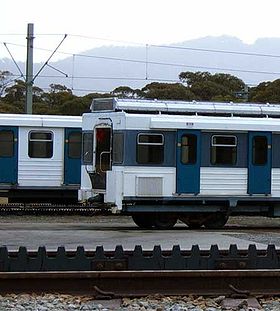Ski tube
| Skitube Alpine Railway | |||||||||||||||||||||
|---|---|---|---|---|---|---|---|---|---|---|---|---|---|---|---|---|---|---|---|---|---|
|
Two wagons of the Skitube-Bahn, track in the foreground
| |||||||||||||||||||||
| Route length: | 8.5 km | ||||||||||||||||||||
| Gauge : | 1435 mm ( standard gauge ) | ||||||||||||||||||||
| Power system : | 1,500 = | ||||||||||||||||||||
| Maximum slope : | 125 ‰ | ||||||||||||||||||||
| Rack system : | Von Roll type, lamella with 100 mm pitch |
||||||||||||||||||||
|
|||||||||||||||||||||
Under the name Skitube runs a cog railway in the ski resort of Perisher Valley and Blue Cow in New South Wales , Australia . The name is derived from skiing and the fact that the train mainly runs in a circular bored tunnel (in the English tube , see also London Underground ). The train runs from Bullocks Flat (1,125 meters above sea level) to Perisher Valley and on to Blue Cow (1905 meters above sea level).
The railway construction began in October 1984 in the stations Bullocks Flat and Perisher as well as with the tunnel construction of the Bilston tunnel. The tunnel was named after the initiator of the railway, Ken Bilston. The line is single-lane and has two crossing stations, one at the lower entrance of the Bilston tunnel, the second in the Perisher station.
The railway was opened in 1987 to Perisher Valley, and a year later to Blue Cow. The latter station is only accessible by rail, i.e. i.e., it cannot be reached elsewhere. Deutsche Bahn also takes on the logistics of the restaurants there.
The vehicles and railway equipment were supplied by a consortium consisting of the Australian company Comeng and the two Swiss companies SLM and BBC . All three companies are now part of Bombardier or Stadler Rail .
Four railcars, four control cars and three intermediate cars were delivered. With a car body width of 3500 mm, these are the widest cogwheel vehicles in the world.
The train runs primarily in winter in the southern hemisphere from June to October. Limited operation takes place in summer. The trains are usually composed of four cars, each 16.8 m in length and each capable of carrying 225 passengers. The peak capacity per hour is around 4,500 passengers.
Except for one derailment in 2004, the railway has not had any accident (as of January 2006).
Web links
- Homepage (English)
Coordinates: 36 ° 22 ′ S , 148 ° 24 ′ E
